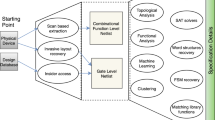Abstract
Prompt detection of even small delay faults, sometimes before causing critical paths to fail, gains importance since stricter test quality requirements for high performance and high density VLSI circuits have to be satisfied in critical applications. This can be achieved by using concurrent delay testing.
In this paper a novel idea for concurrent detection of two-rail path delay faults is introduced. It is shown that TSC two-rail code error indicators that monitor pairs of paths with similar propagation delays can be used for concurrent delay testing. Our technique is applied to TSC two-rail code checkers as well as to duplication systems which are the most widely used TSC systems. The design of TSC two-rail code checkers and TSC duplication systems with respect to two-rail path delay faults is achieved for first time in the open literature.
Similar content being viewed by others
References
Y. Savaria, N. Rumin, J. Hayes, and V. Agarwal, “Soft-Error Filtering: A Solution to the Reliability Problem of Future VLSI Logic Circuits,” Proc. of the IEEE, May 1986, Vol. 74, pp. 669–683.
F. Wakerly, Error Detecting Codes, Self-Checking Circuits and Applications, Elsevier-North Holland, New York, 1978.
M.H. Woods, “MOS VLSI Reliability and Yield Trends,” Proceedings of the IEEE, Dec. 1986, Vol. 74, No. 12, pp. 1715–1729.
W.K.C. Lam and R.K. Brayton, “Timed Boolean Functions: A Unified Formalism for Exact Timing Analysis,” Kluwer Academic Publishers, 1994.
P. Franco and E.J. McCluskey, “On-Line Delay Testing of Digital Circuits,” Proc. of the 12th IEEE VLSI Test Symposium, April 1994, pp. 167–173.
N. Gaitanis, D. Gizopoulos, A. Paschalis, and P. Kostarakis, “An Asynchronous Totally Self-Checking Two-Rail Code Error Indicator,” Proc. of the 14th IEEE VLSI Test Symposium, 1996, pp. 151–156.
S.D. Millman and E.J. McCluskey, “Bridging, Transition, and Stuck-Open Faults in Self-Testing CMOS Checkers,” Proc. of the 21st Fault Tolerant Computing Symposium, 1991, pp. 154–161.
J.C. Lo, “A Novel Area-Time Efficient Static CMOS Totally Self-Checking Comparator,” IEEE Journal of Solid-State Circuits, Vol. 28, No. 2, pp. 165–168, Feb. 1993.
S.M. Reddy, I. Pomeranz, and R. Jain, “Codeword Testing of Two-Rail and Parity TSC Checkers for Delay Faults,” Proc. of 1st IEEE Inter. On-Line Testing Workshop, July 1995, pp. 228–232.
A.N. Usas, “A Totally Self-Checking Checker Design for the Detection of Errors in Periodic Signals,” IEEE Transactions on Computers, Vol. 24, pp. 483–488, May 1975.
B.W. Johnson, Design and Analysis of Fault-Tolerant Digital Systems, Addison-Wesley, 1989.
C. Metra, M. Favalli, P. Olivo, and B. Ricco, “Design of CMOS Checkers with Improved Testability of Bridging and Transistor Stuck-on Faults,” Journal of Electronic Testing: Theory and Applications, Vol. 6, No. 1, pp. 7–22, Feb. 1995.
J.-C. Lo, J.C. Daly, and M. Nicolaidis, “A Strongly Code Disjoint Built-in Current Sensor for Strongly Fault-Secure Static CMOS Realizations,” IEEE Transactions on Computer-Aided Design of Integrated Circuits and Systems, Vol. 14, No. 11, pp. 1402–1407, Nov. 1995.
Author information
Authors and Affiliations
Rights and permissions
About this article
Cite this article
Paschalis, A., Gizopoulos, D. & Gaitanis, N. Concurrent Delay Testing in Totally Self-Checking Systems. Journal of Electronic Testing 12, 55–61 (1998). https://doi.org/10.1023/A:1008213304310
Issue Date:
DOI: https://doi.org/10.1023/A:1008213304310




